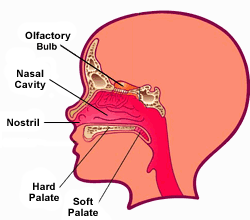on the Road Again Suitcase Up My Nose
A big batch of cookies coming out of the oven. Your gym purse full of muddy clothes. How practise y'all smell these smells and thousands more? It's your nose, of course.
Your nose lets yous smell and it's a big role of why y'all are able to taste things. The olfactory organ is also the main gate to the respiratory arrangement, your body'due south system for animate. Let'southward exist nosy and find out some more almost the nose.
Nose Parts
The olfactory organ has 2 holes called nostrils. The nostrils and the nasal passages are separated by a wall called the septum (say: SEP-tum). Deep inside your nose, close to your skull, your septum is fabricated of very sparse pieces of bone.
Closer to the tip of your nose, the septum is fabricated of cartilage (say: KAR-tel-ij), which is flexible fabric that'due south firmer than peel or muscle. It's not equally hard equally bone, and if you push on the tip of your nose, y'all can experience how wiggly it is.
Behind your nose, in the middle of your face, is a space chosen the nasal cavity. It connects with the back of the throat. The nasal cavity is separated from the within of your mouth by the palate (roof of your mouth).
Getting the Air in In that location
When you inhale air through your nostrils, the air enters the nasal passages and travels into your nasal cavity. The air then passes down the back of your throat into the trachea (say: TRAY-kee-uh), or windpipe, on its manner to the lungs.

Your nose is also a 2-manner street. When you lot exhale the old air from your lungs, the nose is the main way for the air to leave your body. But your olfactory organ is more than a passageway for air. The nose also warms, moistens, and filters the air before information technology goes to the lungs.
Page ane
The inside of your nose is lined with a moist, thin layer of tissue called a mucous membrane (say: MYOO-kus MEM-brayne). This membrane warms up the air and moistens it. The mucous membrane makes mucus, that sticky stuff in your nose you might phone call snot. Fungus captures dust, germs, and other small particles that could irritate your lungs. If you expect inside your nose, you will also run across hairs that can trap large particles, like clay or pollen.
If something does get trapped in there, yous can probably estimate what happens adjacent. You sneeze. Sneezes tin send those unwelcome particles speeding out of your nose at 100 mph!
Further back in your nose are even smaller hairs called cilia (say: SILL-ee-uh) that you tin see only with a microscope. The cilia move back and forth to move the mucus out of the sinuses and back of the nose. Cilia tin can likewise be found lining the air passages, where they assistance move mucus out of the lungs.
Sniff, Sniff, Accept a Whiff
The nose allows you to make scents of what'south going on in the world around yous. Just equally your eyes give you lot information past seeing and your ears assistance yous out by hearing, the nose lets you figure out what's happening by smelling. Information technology does this with help from many parts hidden deep inside your nasal crenel and head.
Upwards on the roof of the nasal cavity (the space behind your nose) is the olfactory epithelium (say: ol-FAK-tuh-ree eh-puh-THEE-lee-um). Olfactory is a fancy word that has to do with smelling. The olfactory epithelium contains special receptors that are sensitive to odour molecules that travel through the air.
These receptors are very pocket-sized — there are about 10 meg of them in your nose! There are hundreds of different odor receptors, each with the ability to sense certain olfactory property molecules. Research has shown that an odor tin stimulate several different kinds of receptors. The brain interprets the combination of receptors to recognize any one of near 10,000 different smells.
Folio 2
How Signals Get Sent
When the smell receptors are stimulated, signals travel along the olfactory nerve to the olfactory bulb. The olfactory seedling is underneath the forepart of your brain just above the nasal crenel. Signals are sent from the olfactory bulb to other parts of the encephalon to be interpreted every bit a smell you may recognize, like apple pie fresh from the oven. Yum!
Identifying smells is your encephalon'due south style of telling you nearly your environment. Have you ever smelled your toast burning? In an instant, your brain interpreted the smell and a problem and y'all knew to cheque on your toast.
You learned to associate a certain smell with burning and now your brain remembers that smell so you recognize it. Your sense of smell also can assist yous keep safe. For example, it can warn you not to eat something that smells rotten or help you detect smoke before you see a fire.
Tastes Bully!
Most people just recall of the tongue when they recall about gustation. Just you couldn't taste anything without some help from the nose! The ability to odour and taste become together because odors from foods allow us to gustation more than fully.
Take a seize with teeth of food and think most how it tastes. Then pinch your nose and take another seize with teeth. Notice the difference? It'south just some other reason to capeesh your knockout of a olfactory organ!
Source: https://kidshealth.org/en/kids/nose.html
0 Response to "on the Road Again Suitcase Up My Nose"
Post a Comment